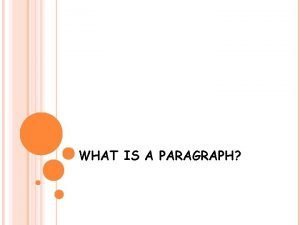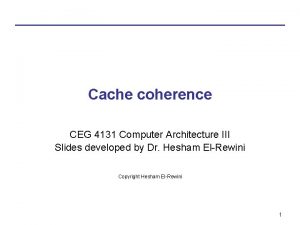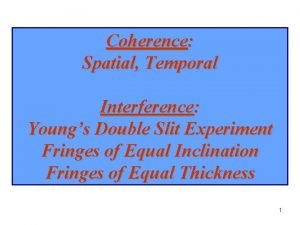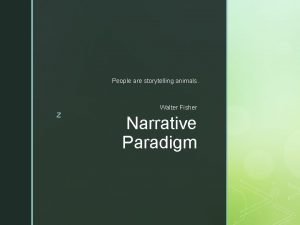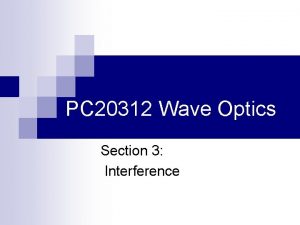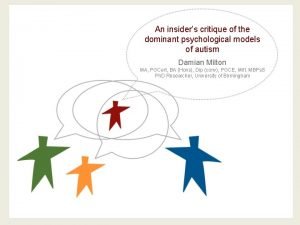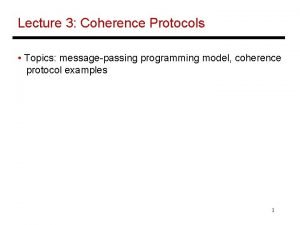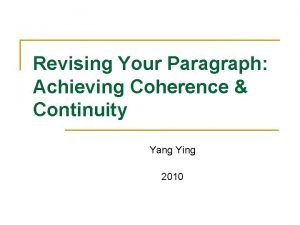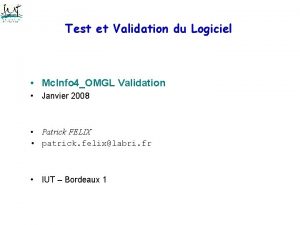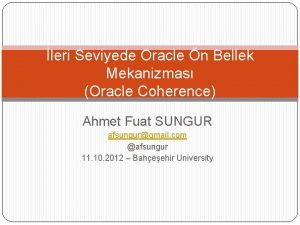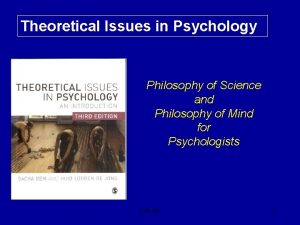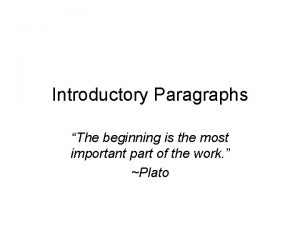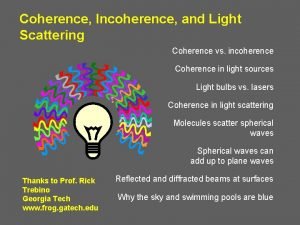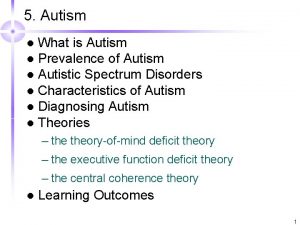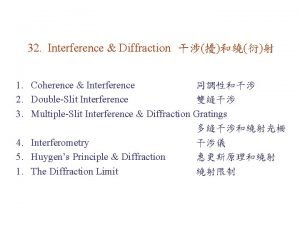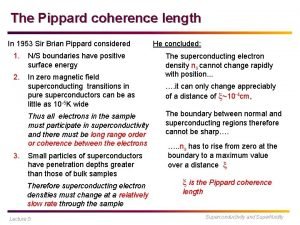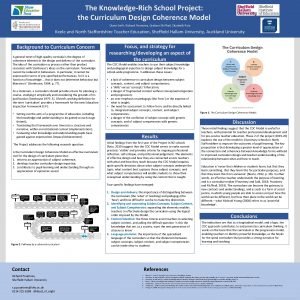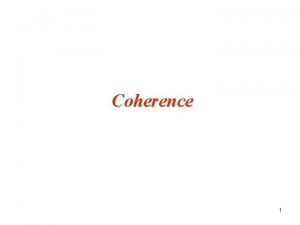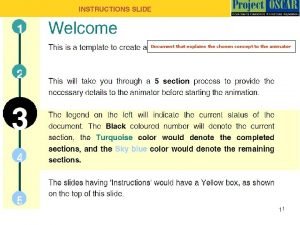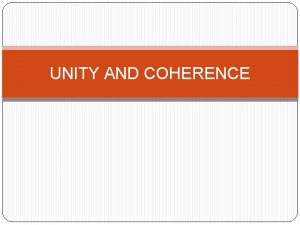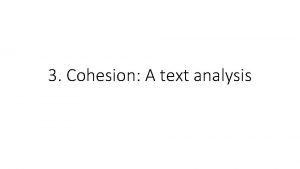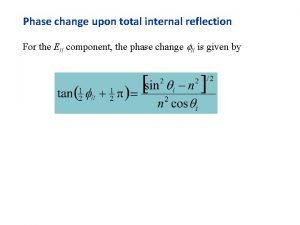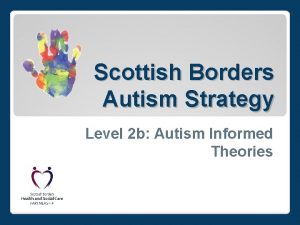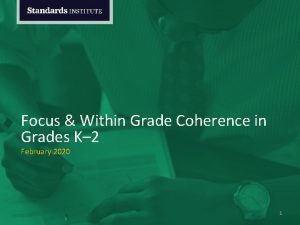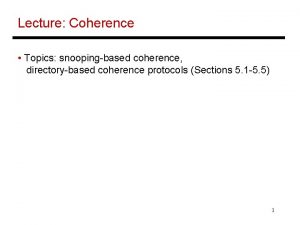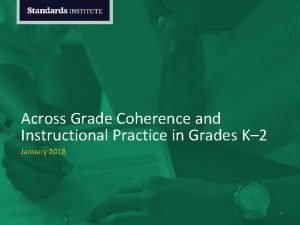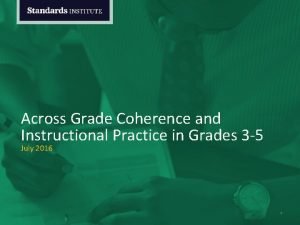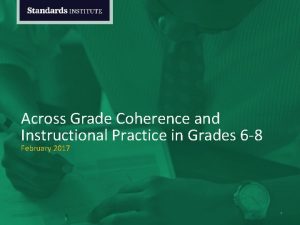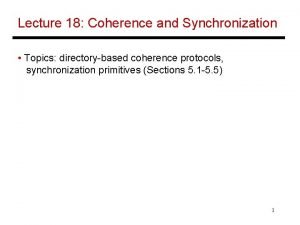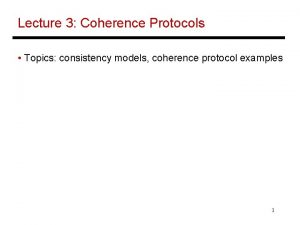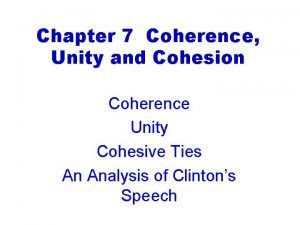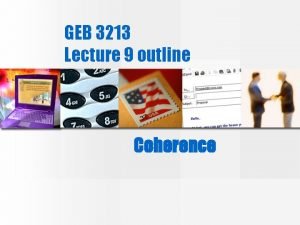Focus Within Grade Coherence in Grades 3 5






















































- Slides: 54

Focus & Within Grade Coherence in Grades 3– 5 January 2018 1

We know from experience the hard work teachers face every day as they strive to help all of their students meet the challenges set by higher Standards. We are a diverse team of current and former classroom teachers, curriculum writers, school leaders, and education experts who have worked in the public, private, and nonprofit sectors. We are dedicated to empowering teachers by providing free, high-quality, Standards-aligned resources for the classroom, the opportunity for unbiased and immersive training through our Institutes, and the option of support through our website offerings. 2

FOCUS IN GRADES 3– 5 Introduction: Who I Am Insert photo Name 1 • • Name 2 • • • 3

FOCUS IN GRADES 3– 5 Introduction: Who You Are Raise your hand if… • • you are a math teacher coach you hold a different role you teach in a district school you teach in a charter school you teach or work in a different type of school or organization you teach monolingual students you teach bilingual or multilingual students 4

FOCUS IN GRADES 3– 5 Icebreaker Share with the people at your table: • Where are you from? • What do you do? • What gets you up in the morning? No, seriously, why do you do this work? Look at the cluster headings on your table. As a group, decide which three clusters you would spend the most time teaching and why. 5

FOCUS IN GRADES 3– 5 The Shifts 1. Focus strongly where the Standards focus. 2. Coherence: Think across grades, and link to major topics within grades. 3. Rigor in major topics: Pursue conceptual understanding, procedural skill and fluency, and application with equal intensity. 6

FOCUS IN GRADES 3– 5 This Week Day Ideas Monday Focus and Within Grade Coherence Tuesday Wednesday Rigor and the Mathematical Practices Across Grade Coherence and Instructional Practice Thursday Adaptation and Curriculum Study Friday Adaptation and Practice “Do the math” Equity for all Connect to our practice 7

FOCUS IN GRADES 3 -5 We Will… • Go deeper on standards and shifts and see how they play out in curriculum and instruction. • Examine standards-aligned resources. • Do a lot of math problems. • Think about how we can ensure equitable math instruction for all students. • Think about how what we are learning impacts what we will do in school. 8

FOCUS IN GRADES 3– 5 We Take Data Seriously • 3 -minute online Daily Survey. Facilitators will address feedback the following day. • Thursday— 10 minute online Knowledge Survey Post-Test. Answer key will be available. 9

FOCUS IN GRADES 3– 5 Norms That Support Our Learning • Take responsibility for yourself as a learner. • Honor timeframes (start, end, and activity). • Be an active and hands-on learner. • Use technology to enhance learning. • Strive for equity of voice. • Contribute to a learning environment in which it is “safe to not know. ” • Identify and reframe deficit thinking and speaking. . 10

FOCUS IN GRADES 3– 5 Today • Morning: Focus in Grades 3– 5 • Afternoon: Focus and Within Grade Coherence in Grades 3– 5 11

FOCUS IN GRADES 3– 5 Morning Objectives • Participants will be able to describe the structure of the standards and how it translates to the learning and teaching of mathematics. • Participants will be able to identify clusters of standards as major, supporting, or additional. • Participants will be able to explain how specific content supports learning and teaching of major work. • Participants will be able to explain how attending to the shift of focus is an equitable practice in Standards-aligned math instruction. 12

FOCUS IN GRADES 3– 5 Morning Agenda I. Framing the Challenge II. Understanding Focus III. Major, Supporting, and Additional Content IV. Deeper Dive: Major Work 13

FOCUS IN GRADES 3– 5 I. Framing the Challenge 14

FOCUS IN GRADES 3– 5 Equity • Equity is engaging in practices that meet students where they are and advance their learning by giving them what they need. It’s about fairness, not sameness. • Equity ensures that all children—regardless of circumstances—are receiving high-quality and Standards-aligned instruction with access to high-quality materials and resources. • We want to ensure that Standards-aligned instruction is a pathway to the equitable practices needed to close the gaps caused by systemic and systematic racism, bias, and poverty. • All week, we will explore our learning through an equity lens, and we will capture those moments visibly here in our room. 15

FOCUS IN GRADES 3 -5 Equity—Envision It So You Can See It For leaders, it is important to have a clear vision of what educationally equitable environments look like. Gorksi and Salwell provide five principles to guide you. 4 min. – Jot down concrete examples of what an equitable education environment would look like, sound like, and feel like to students, families, and staff. 6 min. – Share in pairs at your tables, looking for commonalities and new ideas to expand your thinking. 5 min. – Share with the whole group ideas you heard that will help all of us. Looks Like Sounds Like 16 Feels Like

FOCUS IN GRADES 3– 5 II. A Call for Focus “A focused, coherent progression of mathematics learning, with an emphasis on proficiency with key topics, should become the norm in elementary and middle school mathematics curricula. Any approach that continually revisits topics year after year without closure is to be avoided. By the term focused, the Panel means that curriculum must include (and engage with adequate depth) the most important topics underlying success in school algebra…. Improvements like those suggested in this report promise immediate positive results with minimal additional cost. ” –National Mathematics Advisory Panel 17

FOCUS IN GRADES 3– 5 Focus in the Standards The Common Core calls for greater focus in mathematics. Rather than racing to cover many topics in a mile-wide, inch-deep curriculum, the standards ask math teachers to significantly narrow and deepen the way time and energy are spent in the classroom. This means focusing deeply on the major work of each grade. 18

FOCUS IN GRADES 3– 5 Why Focus? This focus will help students gain strong foundations, including a solid understanding of concepts, a high degree of procedural skill and fluency, and the ability to apply the math they know to solve problems inside and outside the classroom. 19

FOCUS IN GRADES 3– 5 Quick Review Grade Level Domain Cluster Standard 18

FOCUS IN GRADES 3– 5 Where to Focus? 21

FOCUS IN GRADES 3– 5 Focus by Grade Level This shows where students and teachers should spend the large majority of their time in order to meet the expectations of the Standards. • Not all content in a given grade is emphasized equally in the Standards. • Some clusters require greater emphasis than others based on the depth of the ideas, the time that they take to master, and/or their importance to future mathematics or the demands of college and career readiness. • More time in these areas is also necessary for students to meet the Standards for Mathematical Practice. • To say that some things have greater emphasis is not to say that anything in the Standards can safely be neglected in instruction. Neglecting material will leave gaps in student skill and understanding and may leave students unprepared for the challenges of a later grade. 22

FOCUS IN GRADES 3– 5 III. Focus by Grade Level • Major clusters are the highest priority. • Supporting clusters are designed to support and strengthen areas of major emphasis. • Additional clusters may not connect tightly or explicitly to the major work. 23

FOCUS IN GRADES 3– 5 Focus by Grade Level Protocol—Major Work 1. 2. 3. 4. Read the focus document for your grade(s). Identify the major work for the other grades in this grade band. Identify themes for major work across this grade band. 24

“Deficit views of historically marginalized children, their families, and communities because of race, class, language, and culture persist in educational conversations and research (Valencia, 2010)… Deficit thinking implies that students ‘lack’ knowledge and experiences expected by the dominant group. ” –National Council of Supervisors of Mathematics and TODOS: Mathematics for ALL, 2016 25

FOCUS IN GRADES 3– 5 IV. Digging Into Major Work Protocol: 1. Do the math—one task per grade. 2. Identify the standard and why the task aligns. 3. Discuss the alignment with a partner at your table. 4. Explain how you could ensure equitable math instruction for all students with regard to the tasks you choose. 26

FOCUS IN GRADES 3– 5 Major Work—Grade 3 3. OA. A. 3 Many problems can be solved in different ways. Decide if the following word problems can be solved using multiplication. Explain your thinking. Then solve each problem. a. Liam is cooking potatoes. The recipe says you need 5 minutes for every pound of potatoes you are cooking. How many minutes will it take for Liam to cook 12 pounds of potatoes? b. Mel is designing cards. She has 4 different colors of paper and 7 different pictures she can glue on the paper. How many different card designs can she make using one color of paper and one picture? c. Nina can practice a song 6 times in an hour. If she wants to practice the song 30 times before the recital, how many hours does she need to practice? d. Owen is building a rectangular tile patio that is 4 tiles wide and 6 tiles long. How many tiles does he need? 27

FOCUS IN GRADES 3– 5 Major Work—Grade 4 4. NBT. 1 Task Maned wolves are a threatened species that live in South America. People estimate that there about 24, 000 of them living in the wild. The dhole is an endangered species that lives in Asia. People estimate there are ten times as many maned wolves as dholes living in the wild. About how many dholes are there living in the wild? 28

FOCUS IN GRADES 3– 5 Major Work—Grade 5 5. NBT. A. 1 Task Kipton has a digital scale. He puts a marshmallow on the scale, and it reads 7. 2 grams. How much would you expect 10 marshmallows to weigh? Why? Kipton takes the marshmallows off the scale. He then puts on 10 jellybeans, and the scale reads 12. 0 grams. How much would you expect 1 jellybean to weigh? Why? Kipton then takes off the jellybeans and puts on 10 brand-new pink erasers. The scale reads 312. 4 grams. How much would you expect 1, 000 pink erasers to weigh? Why? 29

Lunch 12: 00– 1: 00 30

FOCUS AND WITHIN GRADE COHERENCE IN GRADES 3– 5 Today • Morning: Focus in Grades 3– 5 • Afternoon: Focus and Within Grade Coherence in Grades 3– 5 31

FOCUS AND WITHIN GRADE COHERENCE IN GRADES 3– 5 Afternoon Objectives • Participants will be able to identify connections between content within a grade level. • Participants will be able to evaluate a sample scope and sequence by • determining whether or not it covers grade-level content; • evaluating the amount of time spent on major, supporting, and additional work; and • recognizing purposeful connections between content (i. e. , between major and supporting and between major and major). 32

FOCUS AND WITHIN GRADE COHERENCE IN GRADES 3– 5 Afternoon Agenda I. Deeper Dive: Supporting Work II. Connect to Practice: Impact of Focus III. Coherence Within the Grade IV. Connect to Practice: Evaluate a Scope and Sequence 33

FOCUS AND WITHIN GRADE COHERENCE IN GRADES 3– 5 I. Digging Into Supporting Work Protocol 1. Identify the supporting work for your grade(s) using the focus documents. 2. Do the math—identify the standard. 3. Discuss how this standard supports major work. 34

FOCUS AND WITHIN GRADE COHERENCE IN GRADES 3– 5 Supporting in Grade 3 3. MD. B. 4 Delilah stops under a silver maple tree and collects leaves. At home, she measures the widths of the leaves to the nearest 1/4 inch and records the measurements as shown below. a. Use the data to create a line plot below. b. Explain the steps you took to create the line plot. c. How many more leaves were 6 inches wide than 6 1/2 inches wide? d. Find the three most frequent measurements on the line plot. What does this tell you about the typical width of a silver maple tree leaf? 35

FOCUS AND WITHIN GRADE COHERENCE IN GRADES 3– 5 Supporting in Grade 4 4. MD. A. 1 36

FOCUS AND WITHIN GRADE COHERENCE IN GRADES 3– 5 Supporting in Grade 5 5. MD. A. 1 37

FOCUS AND WITHIN GRADE COHERENCE IN GRADES 3– 5 II. Focus in 3– 5 Connection to practice: • What are the common threads in the major work in Grades 3– 5? • How do supporting clusters connect to the major work? • What impact do the focus documents have on your role? • Why does a focused curriculum lead to greater student success for all students? 38

FOCUS AND WITHIN GRADE COHERENCE IN GRADES 3– 5 III. Coherence Within the Grade 39

Within Grade Coherence: Coherence is built into the standards for each grade through the utilization of complementary topics to support and reinforce a major topic in a grade. This also increases focus in the grade.

FOCUS AND WITHIN GRADE COHERENCE IN GRADES 3– 5 Task Analysis Protocol: 1. Do the math—one task per grade. 2. Identify the standards and why the task aligns. 3. Discuss why this connection is important to show to students. 41

FOCUS AND WITHIN GRADE COHERENCE IN GRADES 3– 5 Grade 3 3. NF. A. 1, 3. NF. A. 3. B, 3. MD. C. 6, and 3. G. A. 2 a. A small square is a square unit. What is the area of this rectangle? Explain. b. What fraction of the area of each rectangle is shaded blue? Name the fraction in as many ways as you can. Explain your answers. c. Shade 1/2 of the area of the rectangle in a way that is different from the rectangles above. d. Shade 2/3 of the area of the rectangle in a way that is different from the rectangles above. 42

FOCUS AND WITHIN GRADE COHERENCE IN GRADES 3– 5 Grade 4 4. NBT. A. 1, 4. OA. A. 1, and 4. NBT. B. 5 There almost 40 thousand fourth graders in Mississippi and almost 400 thousand fourth graders in Texas. There almost 4 million fourth graders in the United States. We write 4 million as 4, 000. How many times more fourth graders are there in Texas than in Mississippi? How many times more fourth graders are there in the United States than in Texas? Use the approximate populations listed above to solve. There about 4 thousand fourth graders in Washington, D. C. How many times more fourth graders are there in the United States than in Washington, D. C. ? 43

FOCUS AND WITHIN GRADE COHERENCE IN GRADES 3– 5 Grade 5 5. NF. A and 5. NF. B. 6 Some of the problems below can be solved by multiplying 1/8 × 2/5, while others need a different operation. Select the ones that can be solved by multiplying these two numbers. For the remaining, tell what operation is appropriate. In all cases, solve the problem (if possible) and include appropriate units in the answer. a. Two-fifths of the students in Anya’s fifth grade class are girls. One-eighth of the girls wear glasses. What fraction of Anya’s class consists of girls who wear glasses? b. A farm is in the shape of a rectangle 1/8 of a mile long and 2/5 of a mile wide. What is the area of the farm? c. There is 2/5 of a pizza left. If Jamie eats another 1/8 of the original whole pizza, what fraction of the original pizza is left over? d. In Sam’s fifth grade class, 1/8 of the students are boys. Of those boys, 2/5 have red hair. What fraction of the class is red-haired boys? e. Only 120 of the guests at the party wore both red and green. If 1/8 of the guests wore red, what fraction of the guests who wore red also wore green? f. Alex was planting a garden. He planted 2/5 of the garden with potatoes and 1/8 of the garden with lettuce. What fraction of the garden is planted with potatoes or lettuce? 44

FOCUS AND WITHIN GRADE COHERENCE IN GRADES 3– 5 Reflection • How will the discussion on within grade coherence impact what you do in school? • Has your thinking about curriculum, instruction, or lesson planning changed, given the discussion on focus and within grade coherence? How? • What have you thought about doing to ensure equitable math instruction for all students in your class? 45

Break

FOCUS AND WITHIN GRADE COHERENCE IN GRADES 3– 5 IV. Connect to Practice “A focused, coherent progression of mathematics learning, with an emphasis on proficiency with key topics, should become the norm in elementary and middle school mathematics curricula. Any approach that continually revisits topics year after year without closure is to be avoided. By the term focused, the Panel means that curriculum must include (and engage with adequate depth) the most important topics underlying success in school algebra…. Improvements like those suggested in this report promise immediate positive results with minimal additional cost. ” –National Mathematics Advisory Panel 47

FOCUS AND WITHIN GRADE COHERENCE IN GRADES 3– 5 Connect to Practice • How do we know if our curriculum is focused and coherent? • What are the focus criteria? • What are the coherent criteria? 48

FOCUS AND WITHIN GRADE COHERENCE IN GRADES 3– 5 Connect to Practice Focus Criteria • Focus on grade-level standards • Appropriate emphasis on major work Coherence Criteria • Complementary topics support and reinforce a major topic • Supporting work integrated with major work 49

FOCUS AND WITHIN GRADE COHERENCE IN GRADES 3– 5 Evaluate a Sample Scope and Sequence Look at the sample scope and sequence. • Does the scope and sequence appropriately focus on grade-level standards and focus on major content? What evidence do you have? • Does the scope and sequence appropriately reflect the idea of within grade coherence? What evidence do you have? Evidence of Focus Evidence of Within Grade Coherence Ways to Improve/What I Want to Investigate Further 50

FOCUS AND WITHIN GRADE COHERENCE IN GRADES 3– 5 Evaluate Your Scope and Sequence Look at the scope and sequence or curriculum map that you brought with you today. • Does the scope and sequence appropriately focus on grade-level standards and focus on major content? What evidence do you have? • Does the scope and sequence appropriately reflect the idea of within grade coherence? What evidence do you have? Evidence of Focus Evidence of Within Grade Coherence Ways to Improve/What I Want to Investigate Further 51

FOCUS AND WITHIN GRADE COHERENCE IN GRADES 3– 5 Evaluate Your Scope and Sequence Further reflection: • How will the focus shift impact your work with creating and/or coaching around scope and sequences? • How will within grade coherence impact your work with creating and/or coaching around scope and sequences? • How does attending to the shifts of focus and within grade coherence contribute to an equitable environment in your math class? 52

Feedback Please fill out the survey located here: www. standardsinstitutes. org • Click “Winter 2018” on the top of the page. • Click “Details” on the center of the page. 49

Reference List Slide Source 6 http: //achievethecore. org/category/419/the-shifts 14 http: //www. highereducation. org/reports/college_readiness/gap. shtml; http: //www. todosmath. org/assets/docs 2016/2016 Enews/3. pospaper 16_wtodos_8 pp. pdf 16 http: //edchange. org/publications/Equity-Literacy-for-All. pdf 17, 47 Foundations for Success: The Final Report of the National Mathematics Advisory Panel, U. S. Department of Education: Washington, DC, 2008. http: //www 2. ed. gov/about/bdscomm/list/mathpanel/report/final-report. pdf 18 -- 19 http: //www. corestandards. org/other-resources/key-shifts-in-mathematics/ 21– 22 http: //achievethecore. org/dashboard/2/search/1/2/0/1/2/3/4/5/6/7/8/9/10/11/12/page/774/focus-by-grade-level-list-pg 25 http: //www. todos-math. org/assets/docs 2016/2016 Enews/3. pospaper 16_wtodos_8 pp. pdf 27 https: //www. illustrativemathematics. org/content-standards/3/OA/A/3/tasks/365 28 https: //www. illustrativemathematics. org/content-standards/4/OA/A/1/tasks/1809 29 https: //www. illustrativemathematics. org/content-standards/5/NBT/A/1/tasks/1562 35 https: //www. engageny. org/resource/grade-3 -mathematics-module-6 -topic-b-lesson-8/file/35606 36 https: //www. engageny. org/resource/grade-4 -mathematics-module-2 -topic-lesson-1 37 https: //www. engageny. org/resource/grade-5 -mathematics-module-1 -topic-lesson-4 42 https: //www. illustrativemathematics. org/content-standards/3/MD/C/6/tasks/1502 43 https: //www. illustrativemathematics. org/content-standards/4/NBT/A/1/tasks/1808 44 https: //www. illustrativemathematics. org/content-standards/5/NF/A/tasks/609 Image Credits: Slide 25 “Back to School” by Mark Bonica (Flickr). Slide 30: “Coffee Break” by Sam Carpenter (Flickr). Slide 39: “Coiled Rope” by Danny Fowler (Flickr). Slide 40: “Puzzling” by Jolene Faber (Flickr). Slide 46: “Latte Art Smile” by Brainy J (Wikimedia Commons). 54
 Focus and coherence
Focus and coherence Focus on form vs focus on forms
Focus on form vs focus on forms Cost focus and differentiation focus
Cost focus and differentiation focus Drivers of differentiation
Drivers of differentiation Actor focus vs object focus
Actor focus vs object focus Interactions in the environment grade 7
Interactions in the environment grade 7 The paragraph is about
The paragraph is about Define coherence and cohesion
Define coherence and cohesion Coherence in essay writing
Coherence in essay writing Unity or sticking togetherness
Unity or sticking togetherness Ela transition words
Ela transition words Chained cache coherence protocol
Chained cache coherence protocol What is temporal and spatial coherence
What is temporal and spatial coherence Topic sentence and supporting details examples
Topic sentence and supporting details examples Unity and coherence
Unity and coherence Narrative coherence and fidelity examples
Narrative coherence and fidelity examples What is temporal and spatial coherence
What is temporal and spatial coherence Central coherence theory autism
Central coherence theory autism Coherence associates
Coherence associates Cache coherence protocols
Cache coherence protocols Logical connectors examples
Logical connectors examples Cohérence info
Cohérence info Coherence oracle
Coherence oracle Pragmatic theory of truth
Pragmatic theory of truth Unity in academic writing
Unity in academic writing What is temporal and spatial coherence
What is temporal and spatial coherence Seed paragraph
Seed paragraph Scattering of light definition
Scattering of light definition Lead paragraph example
Lead paragraph example Cohesion coherence
Cohesion coherence Narrative coherence and fidelity examples
Narrative coherence and fidelity examples Coherence and unity
Coherence and unity Central coherence theory autism
Central coherence theory autism Coherence interference
Coherence interference Discourse example sentence
Discourse example sentence Laser coherence
Laser coherence One team one mission meaning
One team one mission meaning Cache coherence tutorial
Cache coherence tutorial Pippard coherence length
Pippard coherence length Curriculum design coherence model
Curriculum design coherence model Coherence in waves
Coherence in waves Text coherence in nlp
Text coherence in nlp Cooper pairs animation
Cooper pairs animation Optical
Optical Cohesion and coherence
Cohesion and coherence Unity and coherence paragraph
Unity and coherence paragraph Cache coherence example
Cache coherence example Unity and coherence شرح
Unity and coherence شرح Cohesion and coherence
Cohesion and coherence Conceptual coherence
Conceptual coherence Temporal and spatial coherence
Temporal and spatial coherence Coherence data grid
Coherence data grid Central coherence theory autism
Central coherence theory autism Cohesion and coherence presentation
Cohesion and coherence presentation Gpu cache coherence
Gpu cache coherence






